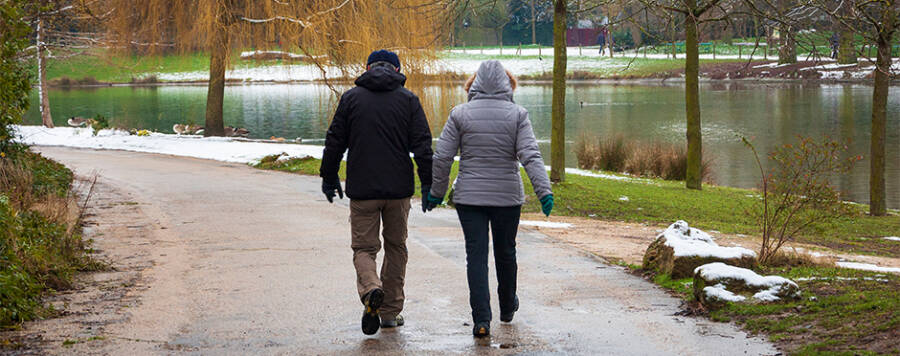Dress for the Weather
Re-evaluate your winter attire this coming season. Make sure you have proper fitting winter boots with wide no-slip soles. Before going out, check that your shoes are tied tight and you have the appropriate amount of layers on. Don’t forget your gloves! Keeping your hands in your pockets may keep them warm, but it is better to have your hands free for balance reactions. If you are using an assistive device (cane or walker), look into getting an ice tip attachment to keep better traction in snow or ice.
Clear your Driveway and Sidewalk
Keep your environment clear of snow or ice. Shoveling is often the cause of injuries or falls in the winter months, so it is important to use caution when clearing snow. Make sure you have proper attire and equipment to remove snow. Only shovel when it is light outside or if you have a well-lit driveway. Use kitty litter or sand to add traction to slippery surfaces. Take breaks to warm up and check the temperature and wind chill prior to going out.
Take your Time
It is better to walk slowly and mindfully in poor weather conditions. Even if you’re in a hurry, spare yourself the increased fall risk and focus on safety. Avoid carrying heavy loads, as they may throw off your center of mass and cause instability. Take those grocery bags in one at a time and take the extra trip to the car. Again, it is best if you can keep at least one hand free for use in case you do lose your balance. When you go to work or run errands, stay on cleared pathways vs cutting corners. It may take a few extra minutes, but it may also save you from a trip to the ER. Always scan and be aware of your environment.
Bring your Phone
Always make sure to bring your phone with you when you go outside. Even if it is just a trip to the mailbox, take your cell phone. Let somebody know when you are going out for a walk or to run errands and give them an expected time you will return home. If you have a life alert, be sure to wear it any time you are leaving the house. Use your phone to check the weather forecast prior to driving to or from work. It may be worth it to be a little late for work so you can wait for the plows to come by.
Bone health
Talk to your physician about bone health. It is common for our bone density to decrease as we age, especially for women due to hormonal changes. Low bone density increases risk of fall-related injuries. If you have osteopenia or osteoporosis, find out what you can do to maintain bone density. Ask your doctor about Calcium and Vitamin D supplements, or see a physical therapist for a new exercise routine to keep your body strong.
Stay active
It is easy to have a decrease in activity level in the winter due to the cold, dark weather. Unfortunately, this year there is the added obstacle of COVID-19. Many of us are no longer going to the gym because of the virus, but that doesn’t mean we should stop working out. There are plenty of ways to stay active within your own house, apartment or condo.
Check out some of our other blogs on home workouts for creative ideas to stay fit. Balance training is a great way to decrease your fall risk inside and out of the home. If you are concerned about your balance and would like individualized training to decrease fall risk, an Athletico physical therapist can help.
These tips can keep you and your loved ones stay safe as we get through the winter season together. If you experience pain or injuries or simply want to improve your balance or overall health, we invite you to reach out to an Athletico near you for a free assessment. Free assessments are available in-clinic and virtually through our Telehealth platform.
Physical therapy is usually the thing you are told to do after medication, x-rays or surgery. The best way to fix your pain is to start where you normally finish – with physical therapy at Athletico. Schedule a free assessment in-clinic or virtually through a secure online video chat where our team can assess your pain and provide recommended treatment options.
The Athletico blog is an educational resource written by Athletico employees. Athletico bloggers are licensed professionals who abide by the code of ethics outlined by their respective professional associations. The content published in blog posts represents the opinion of the individual author based on their expertise and experience. The content provided in this blog is for informational purposes only, does not constitute medical advice and should not be relied on for making personal health decisions.
References:
1. Gevitz, Kathryn et al. “Risk of Fall-Related Injury due to Adverse Weather Events, Philadelphia, Pennsylvania, 2006-2011.” Public health reports (Washington, D.C. : 1974) vol. 132,1_suppl (2017): 53S-58S. doi:10.1177/0033354917706968
2. Dodson, Christopher. “Are You Concerned About Falling on Ice or Snow?” Rothman Orthopedic Institute. Feb 8, 2017. https://rothmanortho.com/stories/blog/falling-on-ice-and-snow

 width="900"
height="356"
>
width="900"
height="356"
>
